

This is a merged information page for Item #1418.
View normal product page.
Pololu item #:
1418
Brand:
Pololu
Status:
Active and Preferred

The Pololu Zumo chassis is a small, tracked robot platform that is less than 10 cm on each side, allowing it to qualify for Mini Sumo competitions. The chassis is composed of black ABS and features a compartment for four AA batteries and sockets for two micro metal gearmotors. It ships as a kit with two silicone tracks, two drive and two idler sprockets, a 1/16″ acrylic mounting plate, and mounting hardware. (Motors and batteries are not included.)
 Compare all products in Chassis or
Compare all products in Chassis or  Zumo Robots and Accessories.
Zumo Robots and Accessories.
 |
Pololu Zumo chassis kit components. |
|---|
 |
Pololu Zumo chassis kit, assembled top view (shown with motors, which are available separately). |
|---|
 |
Pololu Zumo chassis kit, assembled bottom view (shown with motors, which are available separately). |
|---|
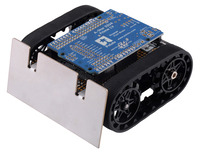 |
Assembled Zumo Robot for Arduino with an Arduino-compatible A-Star 32U4 Prime LV. |
|---|
 |
Example project using the Pololu Zumo chassis with an Arduino. |
|---|
 |
Example robot based on the Pololu Zumo chassis next to a Parallax SumoBot. |
|---|
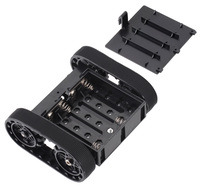 |
Pololu Zumo chassis kit, assembled bottom view with battery holder cover removed. |
|---|
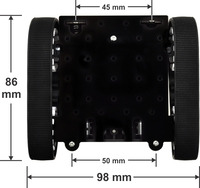 |
Pololu Zumo chassis, assembled top view with dimensions, shown with motors (not included). |
|---|
 |
Pololu Zumo chassis, assembled front view with dimensions. |
|---|
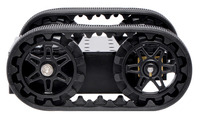 |
Pololu Zumo chassis, assembled side view (shown with motors, which are available separately). |
|---|
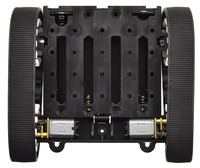 |
Pololu Zumo chassis, assembled top view without acrylic plate, shown with motors (not included). |
|---|
The Zumo chassis kit contains the components necessary to build a small, high-performance tracked robot platform that is compact enough to qualify for Mini Sumo competitions. The chassis is made from black ABS plastic and has sockets for two micro metal gearmotors and a compartment for four AA batteries (motors and batteries are not included). The battery compartment terminals protrude through the chassis and can be accessed from the top side. A black acrylic plate is included with the chassis. This plate holds the motors in place and can be used for mounting your electronics, such as your microcontroller, motor drivers, and sensors.
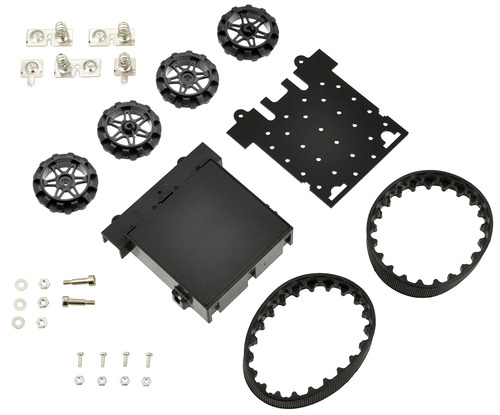 |
Pololu Zumo chassis kit components. |
|---|
The drive system consists of two black silicone tracks, one on each side, that are each supported by a freely spinning idler sprocket and a motor-driven drive sprocket (see the Motors section below for more information on how to select appropriate motors for your robot). These tracks are also available separately in two different lengths and three different sprocket colors.
Assembly instructions are available in the user’s guide under the resources tab.
As of July 2015, this kit is shipping with black, spoked sprockets (see the main product picture and the kit component picture above). Some of the other pictures on this page still show the original white sprockets.
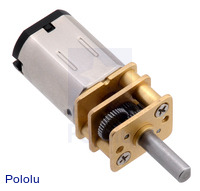 |
Micro Metal Gearmotor with brass gearbox plates. |
|---|
 |
The Zumo chassis uses two motors, one for each tread. The ideal motors for your robot depend on your desired torque, speed, and current draw, so motors are not included with the chassis. We generally recommend using high-power (HP or HPCB, which have long-life carbon brushes) versions of our micro metal gearmotors since the tracks require a decent amount of torque to move effectively; higher gear ratios of the non-HP motors might work if you want lower current draw, but they will be slower and offer less control. Specifically, we primarily recommend the 50:1, 75:1, or 100:1 HP or HPCB motors for use with this chassis. The following table summarizes the key specifications of these three gearmotors. The first four columns are specifications of the motors themselves, while the last column is the measured top speed of a Zumo chassis loaded to a weight of 500 g and driven with these motors. Note that the specifications are for 6V operation, which is approximately the voltage you would get with four alkaline batteries; four NiMH AA cells will typically provide less than 5V.
| Micro Metal Gearmotor |
Free-Run Speed @ 6V |
Stall Torque @ 6V |
Stall Current @ 6V |
Top Zumo Speed @ 6V and 500g |
|
|---|---|---|---|---|---|
| 100:1 HP or 100:1 HPCB | 320 RPM | 30 oz·in | 1600 mA | 20 in/s | (50 cm/s) |
| 75:1 HP or 75:1 HPCB | 400 RPM | 22 oz·in | 1600 mA | 25 in/s | (65 cm/s) |
| 50:1 HP or 50:1 HPCB | 625 RPM | 15 oz·in | 1600 mA | 40 in/s | (100 cm/s) |
You can add your own motor drivers, sensors, and programmable controllers to this chassis, or you can get one of our more complete Zumo robots, which include electronics designed specifically for the Zumo chassis.
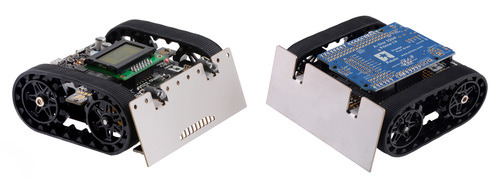 |
A Zumo 32U4 robot (left) and a Zumo robot for Arduino with an A-Star 32U4 Prime LV (right). |
|---|
The original Zumo Robot for Arduino combines a Zumo chassis with a Zumo shield, which includes a dual motor driver, buzzer, and three-axis accelerometer and compass, giving you all the basic mechanical parts and electronics to build an Arduino-controllable robot (Arduino not included). The newer Zumo 32U4 Robot and Zumo 2040 Robot are more highly integrated robots also based on the Zumo chassis that include programmable microcontrollers and even more sensors (e.g. quadrature encoders and a proximity sensor system).
 |
This chassis works with four AA batteries. We recommend using rechargeable AA NiMH cells, which results in a nominal voltage of 4.8 V (1.2 V per cell). When the batteries are fully charged, they will be well above 5 V, and when they are almost spent, they will be well below 5 V. As such, you might consider using a step-up/step-down voltage regulator to power your logic, since this will hold your logic voltage steady at 5 V, no matter if your battery voltage is above or below 5 V. You can also use alkaline cells, which would nominally give you 6V, but that voltage would drop depending on the load.
We carry a basic stainless steel sumo blade that can be mounted to front of the Zumo chassis. With this blade, the Zumo chassis can push around objects, such as other MiniSumo robots. You can also use the design file for this basic blade as the starting point for a custom sumo blade.
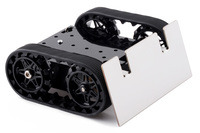 |
Basic sumo blade mounted on a Zumo chassis. |
|---|
The Zumo chassis includes the black sprockets shown in the left picture below, but we also have sprockets available in in red and white that can be purchased separately if you want to add a bit of personalization to your chassis. Note that the white sprockets are white versions of the new, spoked style, not the older style still visible in some of the other pictures on this page that show white sprockets.
|
|
|
Fully assembled, the Zumo chassis is 98 mm wide, 86 mm long, and 39 mm high, with approximately 5 mm of ground clearance.
|
|
Since each side is smaller than 10 cm, this chassis meets Mini-Sumo size requirements. The front screws used to mount the acrylic plate to the chassis can also be used to mount a front scoop that can extend up to 14 mm before exceeding the Mini Sumo limits. The assembled Zumo chassis weighs approximately 210 g with motors and batteries.
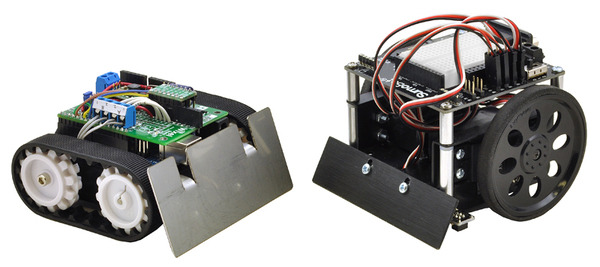 |
Example robot based on the Pololu Zumo chassis next to a Parallax SumoBot. |
|---|
User’s guide for the Pololu Zumo chassis.
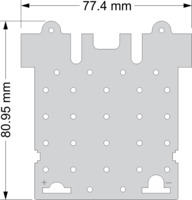 |
Note: this model includes micro metal gearmotors that are sold separately from the Zumo Chassis Kit.
This robot uses a Raspberry Pi and Zumo Chassis Kit and can be remotely controlled over WiFi from an iPhone. The page is written in German, but it has a link at the top to translate it into English using Google Translate. We also wrote about the PiBot-B in our blog.
This article was written by Professor Erich Styger for his class on embedded systems programming at the Lucerne University of Applied Sciences and Arts. It describes various ways to tweak the performance of a Zumo to be more competitive in a Mini Sumo competition. Note that his Zumos use a custom PCB rather than our Zumo shield for Arduino; our shield has a lot of capacitance in parallel with the batteries that generally prevents the “battery inertia” problem Erich describes.
No FAQs available.
MINTomat lets you operate two robot arms and a wirelessly controlled custom robot based on a Pololu Zumo chassis to dispense a gumball in an...
Happy Holidays everyone! I thought it would be fun to share this sumo bot that features Darth Vader/Santa Claus and uses our Zumo chassis. The...
The people at Seewald Solutions posted about their Raspberry Pi-based robot they call ToyCollect. Inspired by the creator’s daughter, who hides her...
Forum user Erich uses our Zumo chassis as a platform for teaching robotics, but instead of using the Zumo shield, he has been making his own custom...
Forum user Pablo shared his Wi-Fi controlled robot with pictures and videos from his Instagram. In Pablo’s forum post, he summarizes his project,...
Erich, a professor at the Lucerne University of Applied Sciences and Arts in Switzerland, posted to our forum about a circuit he designed for the...
Frédéric Jelmoni built a neat robot with a Raspberry Pi and a Zumo Chassis Kit. The Raspberry Zumo robot can be controlled over WiFi using telnet....
Erich, a professor at the Lucerne University of Applied Sciences and Arts in Switzerland, posted to our forum about their first Mini Sumo...